Last Updated on December 29, 2021 at 6:26 pm
In response to our article, “Do we need to invest in international mutual funds?“, a reader claimed that the Nasdaq 100 or the S&P 500 would beat the Sensex over the long term for sure. Is this just another opinion based on personal faith, or does it have any past performance support?
We find out by comparing the rolling returns of the Sensex total returns index with the S&P 500 Total return index in INR and the Nasdaq 100 total return index in INR.
There is a difference in the way in which capital gains and dividends of these indices are taxes. Therefore we decide to ignore taxes in this comparison. It would be safe to assume that the US-based index return would be lowered by about 10% due to tax. In addition, the expense ratio will have to be considered.
Let first start with Sensex TRI vs S and P 500 TRI in INR vs Nasdaq 100 TRI in INR since 5th March 1999.
Join 32,000+ readers and get free money management solutions delivered to your inbox! Subscribe to get posts via email! (Link takes you to our email sign-up form)
🔥Want to create a complete financial plan? Learn goal-based investing? Exclusive access to our DIY tools? Increase your income with your skills? Enjoy massive discounts on our robo-advisory tool & courses! 🔥
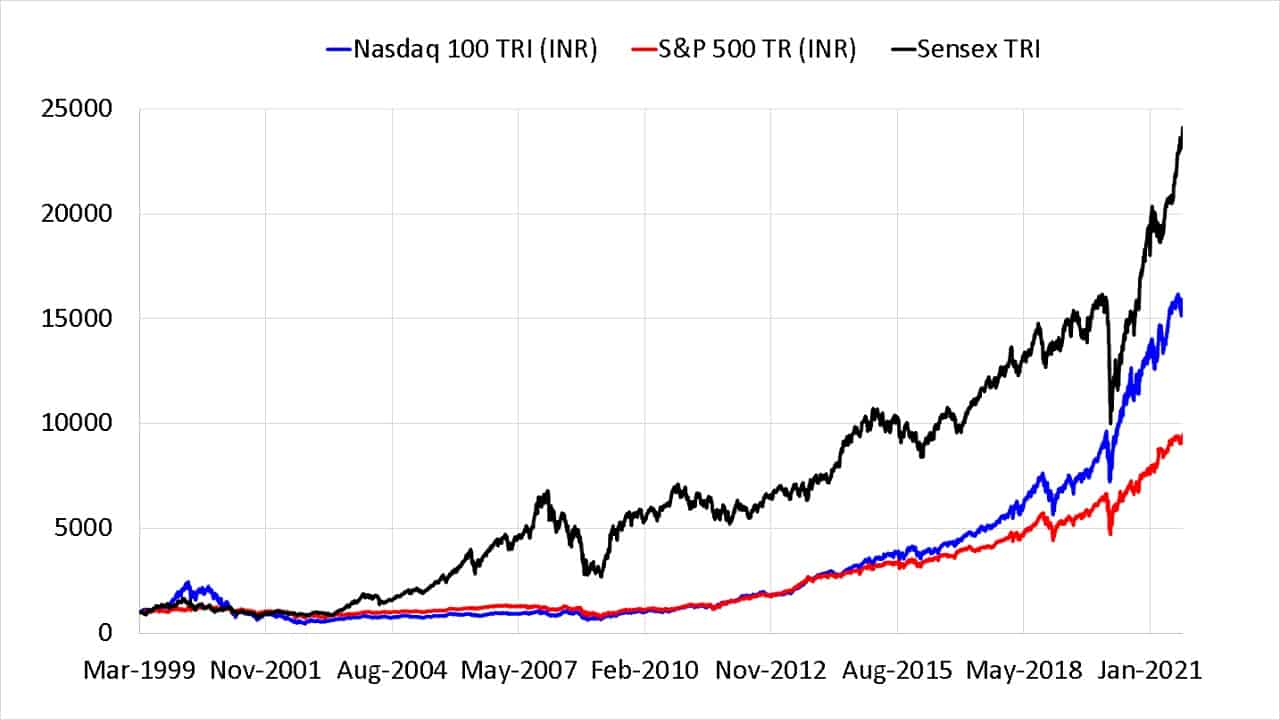
Sensex has done quite well in the last two decades, but let us dig deeper with 5, 10, 15 and 20-year rolling returns. The number in the small grey box within the chart represents the number of rolling returns data points for the Sensex.
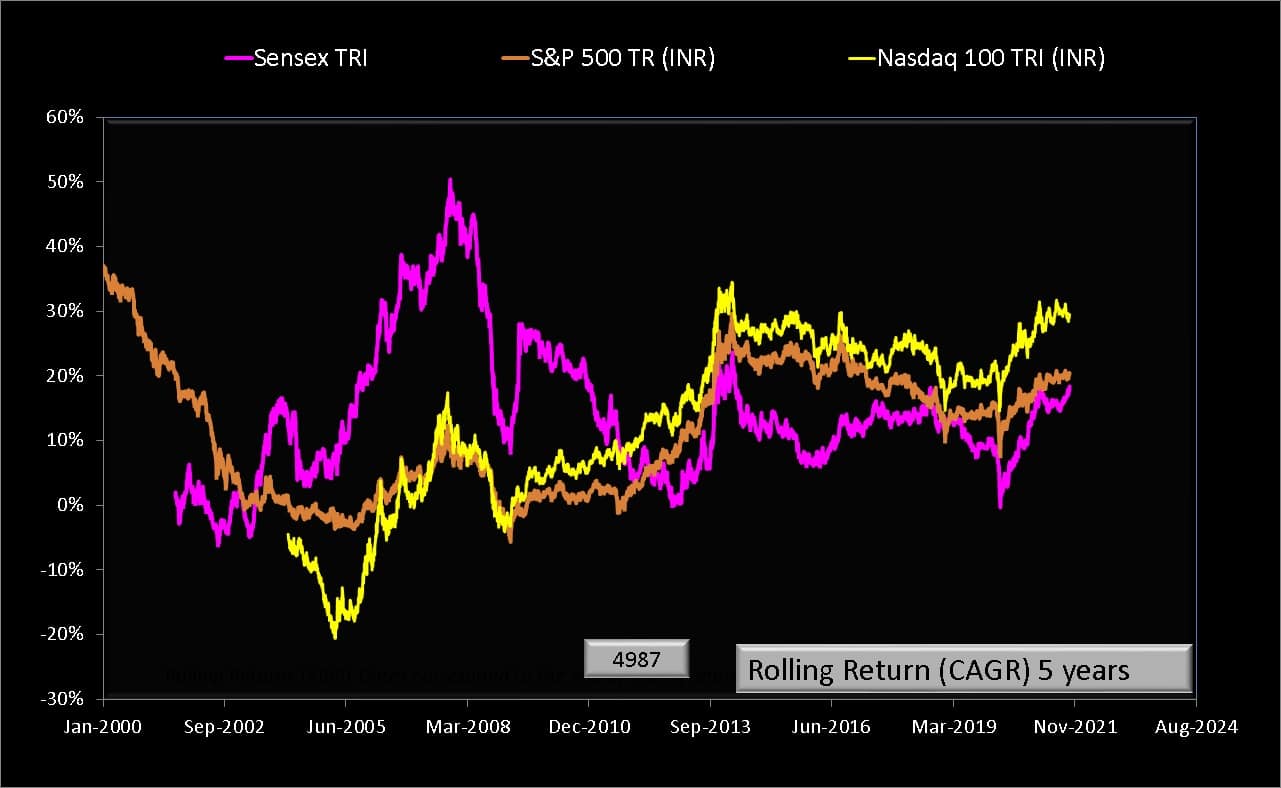
We can expect the S&P 500 to outperform the Sensex in the ’90s when our economics and politics were turbulent. For about ten years, the Sensex outperformed both the US indices. The tide again turned from late 2013. This is the key takeaway from this comparison. The performance will be cyclic but with an unknown frequency.
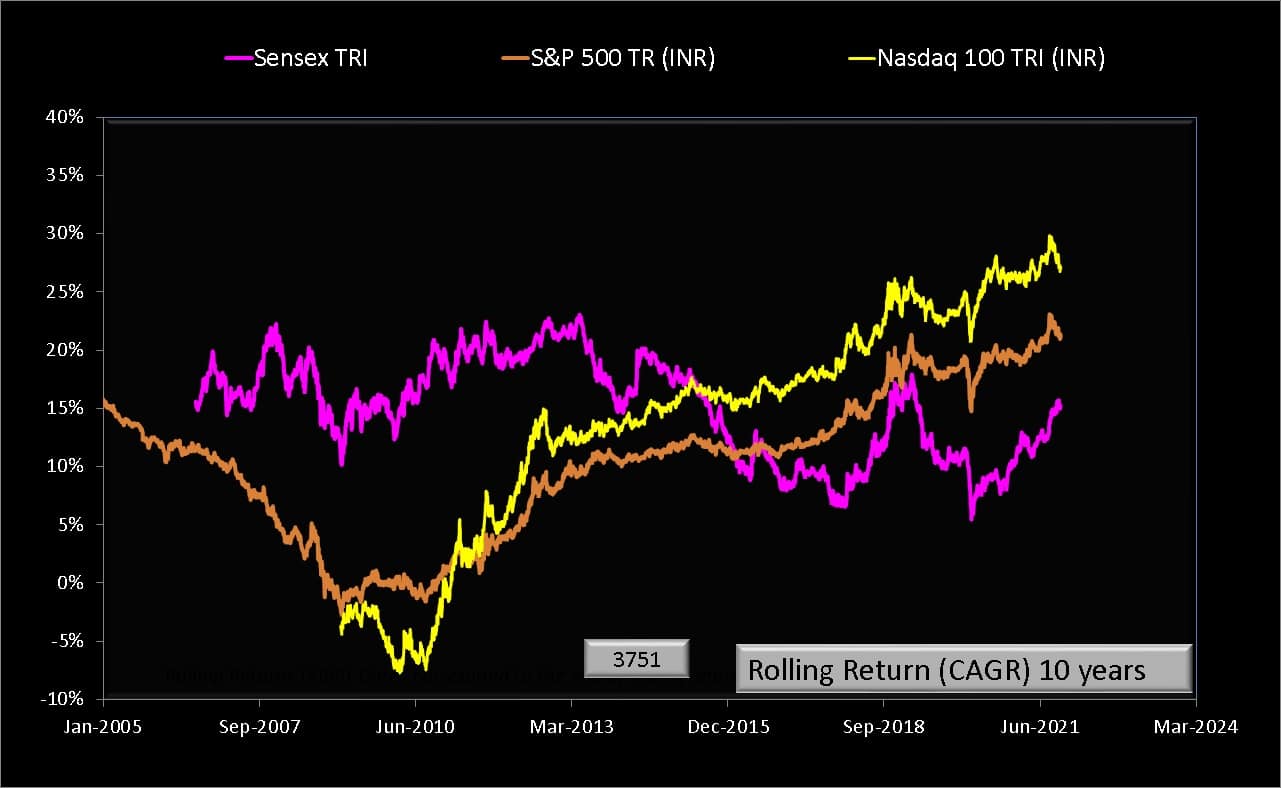
The recent outperformance of the US-indices is again seen in the 10-year rolling returns chart.
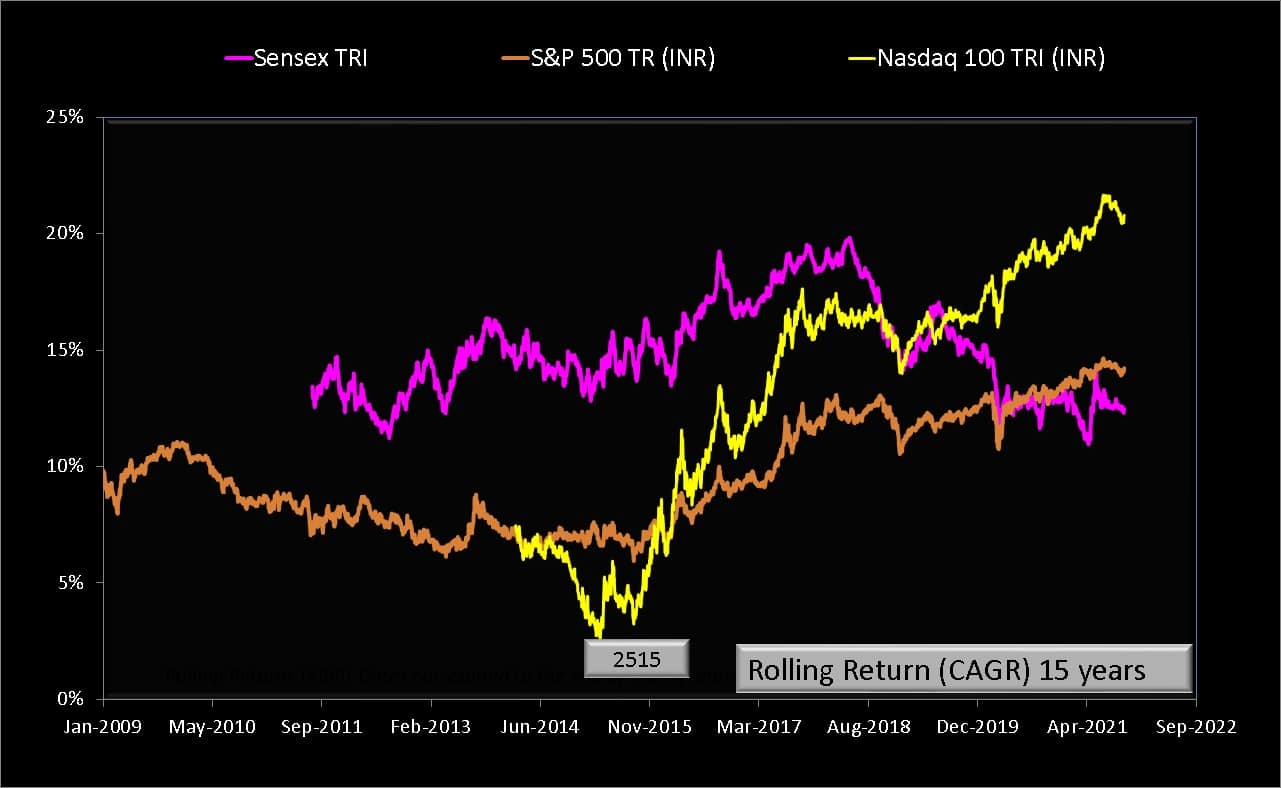
You can appreciate why investors now want a piece of the Nasdaq 100 or the S &P 500. Since late 2017, the 15-year Sensex return has been southward bound while the US-indices, particularly the Nasdaq 100, has been moving up. It would be prudent to expect cyclic behaviour over this tenure as well.
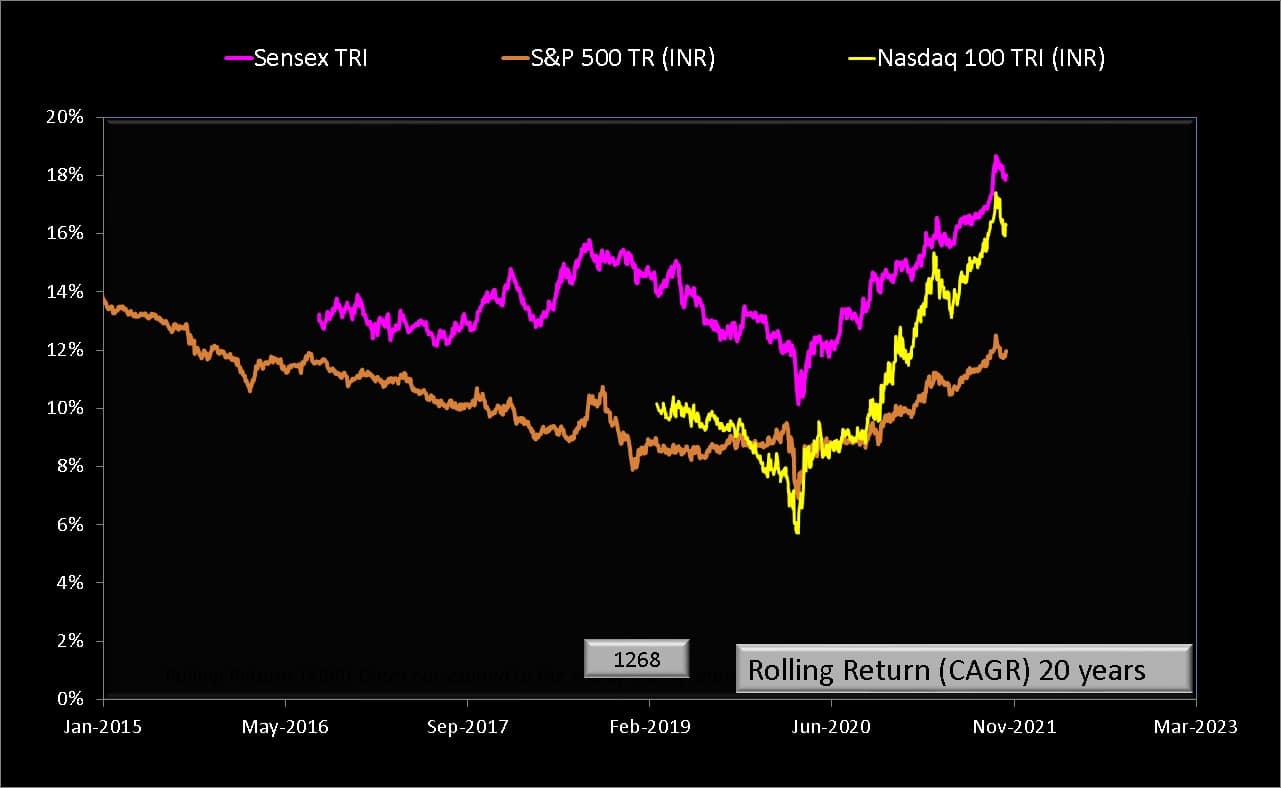
The S&P 500 is significantly lower than that of the Sensex. The Nasdaq 100 has narrowed the gap in the recent past but is just a bit short (taxes and expense ratio would lower this further). In future, the US-indices can beat the Sensex over this tenure, or it may not happen for some time to come. To state the obvious, we do not know.
So the point is, the reader’s claim that the US-indices will comfortably beat the Sensex over the long-term has no past performance support. Does it have intuitive support? Just because the NASAQ 100 or the S&P 500 is dominated by tech giants with a global footprint today, can we expect these indices to beat the Sensex? It is possible but only just as probable as the opposite scenario.
The above gives some confidence that sticking to Indian equity is not such a bad deal. There is a reasonable chance of beating inflation with it. See: Why should I invest in equity mutual funds when there is no guarantee of returns?
Now let us consider the idea of diversification with US indices. Quants would like to measure this in terms of correlation factors. IMO the only metric that is easy to appreciate is the one-year return which we can see easily from a rolling returns chart. One year because this is the normal frequency of rebalancing. Looking for correlation over shorter periods may be technically correct but is not helpful to a common investor.
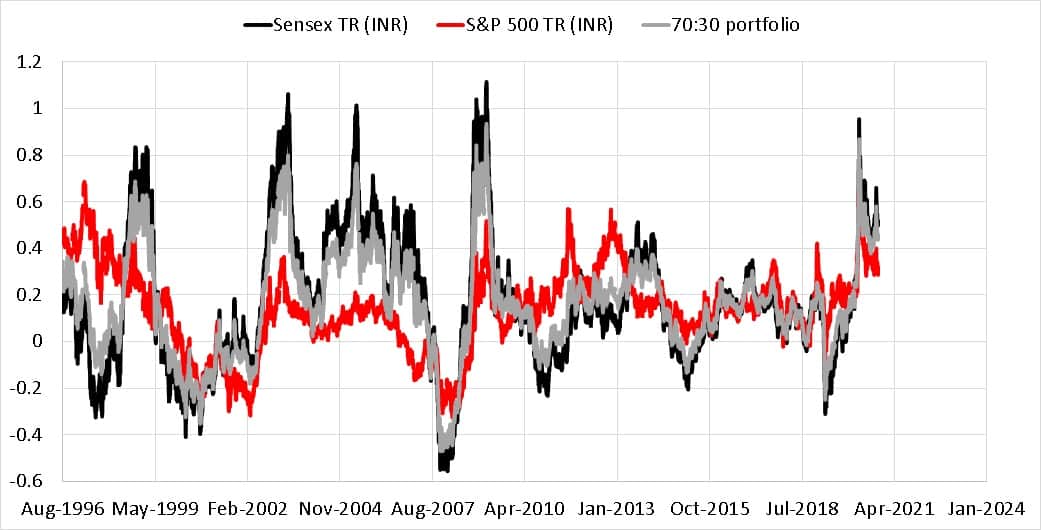
One cannot expect a perfect negative correlation – that is, the S&P 500 giving a positive one-year return when the Sensex return is negative for the same period. This happens sometimes and sometimes not.
If we assume a yearly rebalance between the two equity indices, then for a 30% S&P 500 and 70% Sensex mix, the one-year rolling returns are shown in grey above. The grey line mimics the Sensex with slightly lower returns as it is the dominant contribution. Please note that most investors have much lower international equity exposure. There is, however, one drawback in this illustration: There is no fixed income component involved in the rebalancing.
If the trend shown above continues in the future, considering that the Sensex 1Y return frequently outperforms the 1Y S&P 500 return, increasing the international equity exposure would only limit us from benefiting from the upside potential of Indian equity.
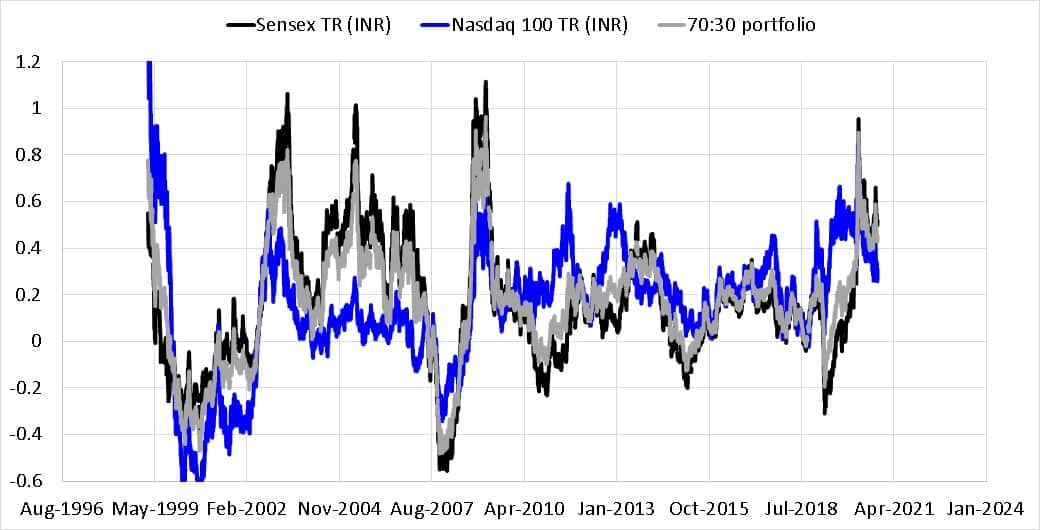
The scenario with Nasdaq 100 is similar, although its upside potential is higher due to its higher volatility.
In summary, one can see that the Sensex performance is reasonably good compared to the S&P 500 and the Nasdaq 100. Investors who wish to only invest in Indian equity are not worse off than those who desire international diversification. The recent outperformance of the US-indices over 5 to 15 year periods may not persist in future. Portfolio diversification, as discussed earlier, comes at a price – higher management fee, higher taxes and maintenance (regular rebalancing). Very few investors are capable of appreciating or implementing this.
🔥Enjoy massive discounts on our courses, robo-advisory tool and exclusive investor circle! 🔥& join our community of 7000+ users!
Use our Robo-advisory Tool for a start-to-finish financial plan! ⇐ More than 2,500 investors and advisors use this!
Track your mutual funds and stock investments with this Google Sheet!
We also publish monthly equity mutual funds, debt and hybrid mutual funds, index funds and ETF screeners and momentum, low-volatility stock screeners.





- Do you have a comment about the above article? Reach out to us on Twitter: @freefincal or @pattufreefincal
- Have a question? Subscribe to our newsletter using the form below.
- Hit 'reply' to any email from us! We do not offer personalized investment advice. We can write a detailed article without mentioning your name if you have a generic question.
Join 32,000+ readers and get free money management solutions delivered to your inbox! Subscribe to get posts via email! (Link takes you to our email sign-up form)
About The Author
 Dr M. Pattabiraman(PhD) is the founder, managing editor and primary author of freefincal. He is an associate professor at the Indian Institute of Technology, Madras. He has over ten years of experience publishing news analysis, research and financial product development. Connect with him via Twitter(X), Linkedin, or YouTube. Pattabiraman has co-authored three print books: (1) You can be rich too with goal-based investing (CNBC TV18) for DIY investors. (2) Gamechanger for young earners. (3) Chinchu Gets a Superpower! for kids. He has also written seven other free e-books on various money management topics. He is a patron and co-founder of “Fee-only India,” an organisation promoting unbiased, commission-free investment advice.
Dr M. Pattabiraman(PhD) is the founder, managing editor and primary author of freefincal. He is an associate professor at the Indian Institute of Technology, Madras. He has over ten years of experience publishing news analysis, research and financial product development. Connect with him via Twitter(X), Linkedin, or YouTube. Pattabiraman has co-authored three print books: (1) You can be rich too with goal-based investing (CNBC TV18) for DIY investors. (2) Gamechanger for young earners. (3) Chinchu Gets a Superpower! for kids. He has also written seven other free e-books on various money management topics. He is a patron and co-founder of “Fee-only India,” an organisation promoting unbiased, commission-free investment advice.Our flagship course! Learn to manage your portfolio like a pro to achieve your goals regardless of market conditions! ⇐ More than 3,000 investors and advisors are part of our exclusive community! Get clarity on how to plan for your goals and achieve the necessary corpus no matter the market condition is!! Watch the first lecture for free! One-time payment! No recurring fees! Life-long access to videos! Reduce fear, uncertainty and doubt while investing! Learn how to plan for your goals before and after retirement with confidence.
Our new course! Increase your income by getting people to pay for your skills! ⇐ More than 700 salaried employees, entrepreneurs and financial advisors are part of our exclusive community! Learn how to get people to pay for your skills! Whether you are a professional or small business owner who wants more clients via online visibility or a salaried person wanting a side income or passive income, we will show you how to achieve this by showcasing your skills and building a community that trusts and pays you! (watch 1st lecture for free). One-time payment! No recurring fees! Life-long access to videos!
Our new book for kids: “Chinchu Gets a Superpower!” is now available!


Must-read book even for adults! This is something that every parent should teach their kids right from their young age. The importance of money management and decision making based on their wants and needs. Very nicely written in simple terms. - Arun.Buy the book: Chinchu gets a superpower for your child!
How to profit from content writing: Our new ebook is for those interested in getting side income via content writing. It is available at a 50% discount for Rs. 500 only!
Do you want to check if the market is overvalued or undervalued? Use our market valuation tool (it will work with any index!), or get the Tactical Buy/Sell timing tool!
We publish monthly mutual fund screeners and momentum, low-volatility stock screeners.
About freefincal & its content policy. Freefincal is a News Media Organization dedicated to providing original analysis, reports, reviews and insights on mutual funds, stocks, investing, retirement and personal finance developments. We do so without conflict of interest and bias. Follow us on Google News. Freefincal serves more than three million readers a year (5 million page views) with articles based only on factual information and detailed analysis by its authors. All statements made will be verified with credible and knowledgeable sources before publication. Freefincal does not publish paid articles, promotions, PR, satire or opinions without data. All opinions will be inferences backed by verifiable, reproducible evidence/data. Contact information: To get in touch, use this contact form. (Sponsored posts or paid collaborations will not be entertained.)
Connect with us on social media
- Twitter @freefincal
- Subscribe to our YouTube Videos
- Posts feed via Feedburner.
Our publications
You Can Be Rich Too with Goal-Based Investing
 Published by CNBC TV18, this book is meant to help you ask the right questions and seek the correct answers, and since it comes with nine online calculators, you can also create custom solutions for your lifestyle! Get it now.
Published by CNBC TV18, this book is meant to help you ask the right questions and seek the correct answers, and since it comes with nine online calculators, you can also create custom solutions for your lifestyle! Get it now.Gamechanger: Forget Startups, Join Corporate & Still Live the Rich Life You Want
 This book is meant for young earners to get their basics right from day one! It will also help you travel to exotic places at a low cost! Get it or gift it to a young earner.
This book is meant for young earners to get their basics right from day one! It will also help you travel to exotic places at a low cost! Get it or gift it to a young earner.Your Ultimate Guide to Travel
 This is an in-depth dive into vacation planning, finding cheap flights, budget accommodation, what to do when travelling, and how travelling slowly is better financially and psychologically, with links to the web pages and hand-holding at every step. Get the pdf for Rs 300 (instant download)
This is an in-depth dive into vacation planning, finding cheap flights, budget accommodation, what to do when travelling, and how travelling slowly is better financially and psychologically, with links to the web pages and hand-holding at every step. Get the pdf for Rs 300 (instant download)